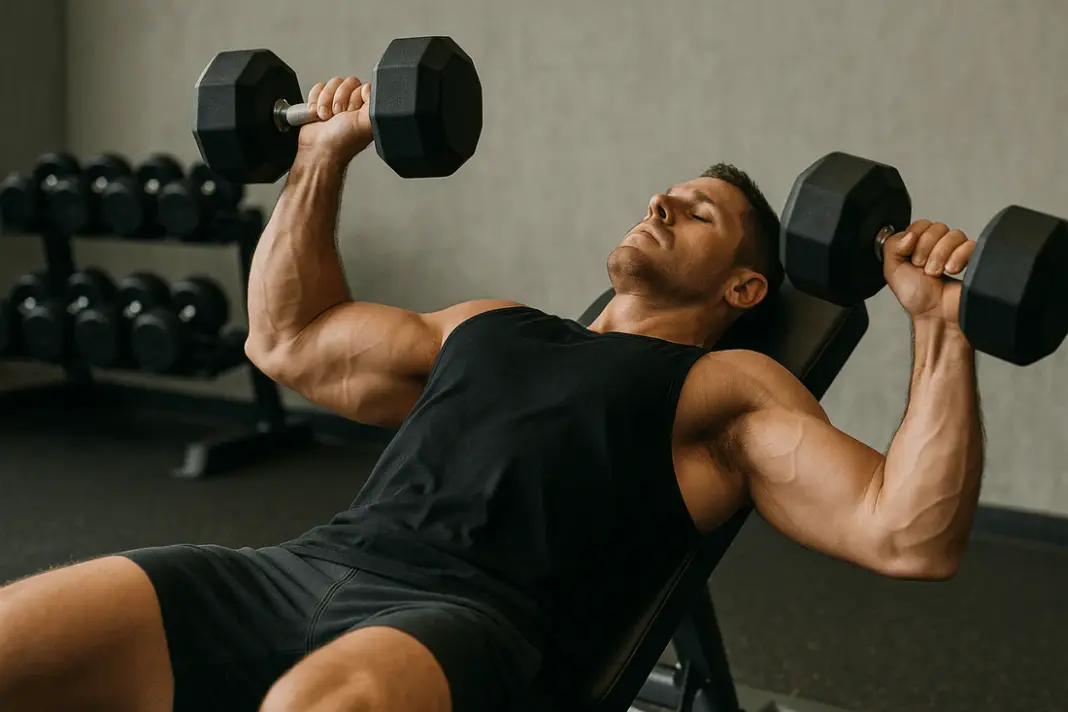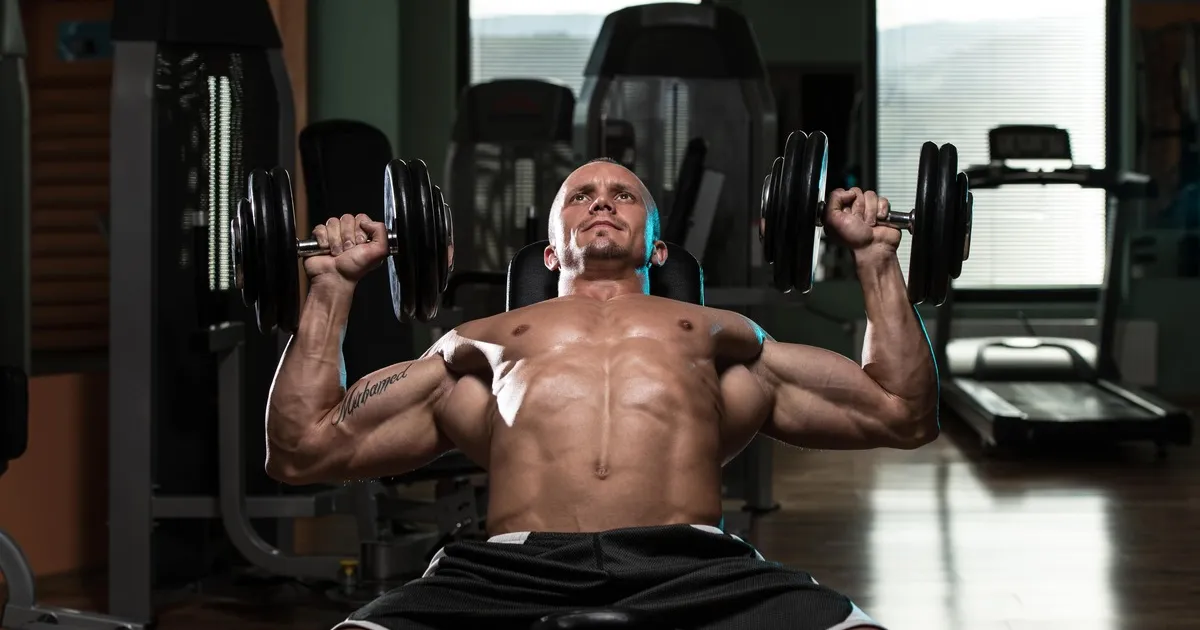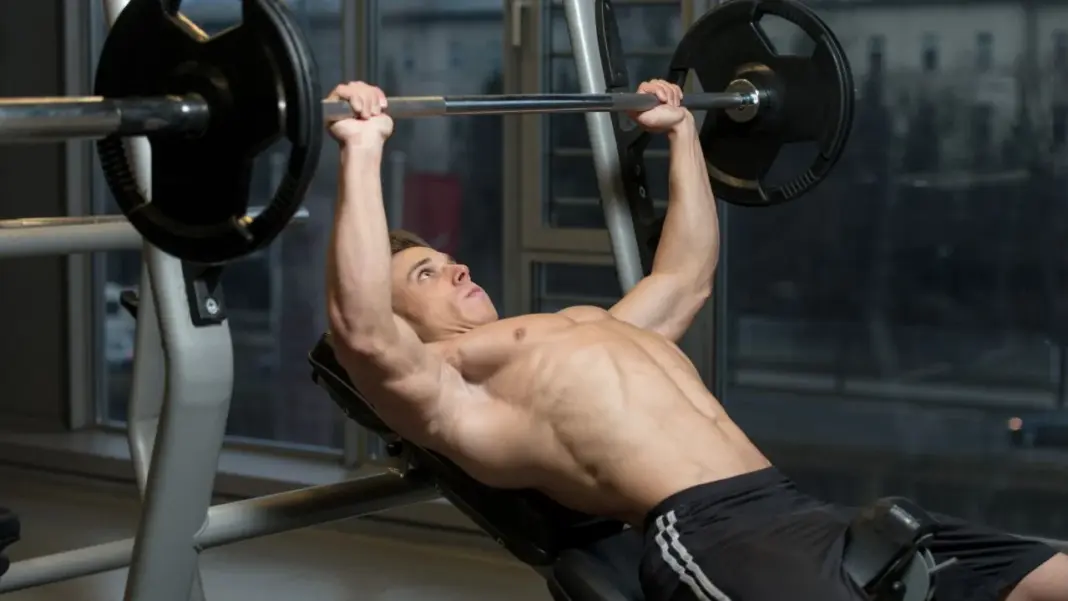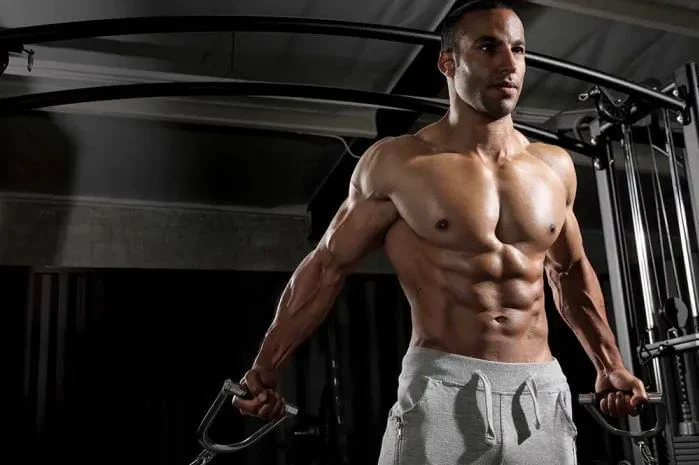Incline Dumbbell Press: Sculpting the Upper Chest with Precision and Freedom
If the Incline Barbell Bench Press is the upper chest’s foundation, then the Incline Dumbbell Press is its sculpting tool.
It allows a freer range of motion, deeper stretch, and a more refined mind–muscle connection than its barbell counterpart — giving you the ability to carve out the upper chest fibers and develop that 3D fullness bodybuilders strive for.
This movement brings a perfect balance of strength and symmetry, letting each side of the chest work independently while recruiting stabilizers for complete muscular engagement.
It’s the exercise where the mechanics of control meet the art of aesthetics — and for physique-focused lifters, it’s non-negotiable.
Muscles Worked
The Incline Dumbbell Press targets the clavicular head of the pectoralis major, but it engages a network of supporting muscles for both power and precision.
- Primary Muscle:
- Upper Pectoralis Major (Clavicular Head)
- Secondary Muscles:
- Anterior Deltoids (Front Shoulders)
- Triceps Brachii (Elbow Extension)
- Serratus Anterior (Scapular Control)
- Stabilizers (Forearms, Core, Rotator Cuff)
This synergy makes it a go-to for balanced chest development — pressing power without the barbell’s restrictions.
The Setup
- Bench Angle:
Set your bench between 30° and 45°.- Lower angle (30°) → Emphasizes the chest more.
- Higher angle (45°) → Brings in more shoulders.
Most lifters find 30–35° optimal for pure upper pec recruitment.
- Dumbbell Selection:
Choose dumbbells that allow full range of motion and control — ego lifting kills this movement’s precision. - Body Positioning:
- Sit back on the incline bench, feet planted firmly.
- Retract your scapulae (pull shoulders back and down).
- Keep your chest tall and tight throughout the movement.
How to Perform the Incline Dumbbell Press
Step-by-Step Execution
- Starting Position:
- Hold the dumbbells at shoulder level with palms facing forward.
- Your wrists should be directly above your elbows.
- Engage your core and take a deep breath.
- Lowering Phase (Eccentric):
- Slowly lower the dumbbells toward your upper chest.
- Aim for the bells to reach chest height or slightly below for a deep stretch.
- Keep your elbows at a 45° angle to the torso — not flared.
- Pressing Phase (Concentric):
- Drive the dumbbells upward and slightly inward.
- Don’t slam them together — bring them close enough to feel chest contraction.
- Squeeze your upper pecs at the top for a full second before lowering again.
- Breathing:
- Inhale as you lower.
- Exhale as you press.
Training Strategies & Programming
- Strength Development
For lifters looking to improve upper chest pressing power:
- Sets/Reps: 4–5 sets of 5–8 reps
- Load: 75–80% of your max
- Rest: 2 minutes
- Focus on heavy, clean presses with a strong lockout — control on every rep.
- Hypertrophy (Muscle Growth Focus)
For aesthetic and fullness-focused bodybuilding work:
- Sets/Reps: 3–4 sets of 8–12 reps
- Tempo: 3-second lower, 1-second squeeze at top
- Rest: 60–90 seconds
- Focus on maximum stretch and contraction — not just moving weight.
- Volume Finisher or Superset
To create deep fatigue and maximize the pump:
- Superset with Low-to-High Cable Flyes or Incline Dumbbell Flyes.
- Example:
- 3 sets Incline Dumbbell Press (10–12 reps)
- Immediately follow with Cable Fly (12–15 reps)
- Rest 60–90 seconds.
This combination floods the upper chest with blood, maximizing hypertrophy.
Variations
- Neutral Grip Incline Dumbbell Press
- Palms face each other throughout the press.
- Reduces shoulder strain and increases inner-upper chest engagement.
- Reverse-Grip Dumbbell Press
- Palms face toward you (underhand grip).
- More emphasis on clavicular fibers, excellent for sculpting the upper shelf.
- Alternating Dumbbell Press
- Press one dumbbell at a time.
- Increases time under tension and shoulder stabilization.
- Isometric Incline Dumbbell Hold
- Hold both dumbbells halfway down for 30 seconds after your final set.
- Great finisher for mind–muscle control and endurance.
Common Mistakes & Fixes
- Setting the Bench Too High
- Mistake: Turning the movement into a shoulder press.
- Fix: Stay below 45°, ideally 30–35°, to keep tension on the upper pecs.
- Colliding the Dumbbells
- Mistake: Smashing the dumbbells at the top — removes tension and risks injury.
- Fix: Stop an inch apart and squeeze the pecs instead of the bells.
- Losing Scapular Retraction
- Mistake: Allowing shoulders to roll forward — removes chest tension.
- Fix: Keep your shoulder blades pulled down and back throughout.
- Using Momentum
- Mistake: Bouncing or arching to lift heavier weights.
- Fix: Control every rep; pause slightly at the bottom to eliminate rebound.
- Limited Range of Motion
- Mistake: Partial reps that skip the lower stretch.
- Fix: Lower dumbbells fully until your upper arms are parallel (or slightly below) to the floor.
Bodybuilder’s Technique Cues
✅ “Open the chest, don’t just push the weight.”
✅ “Pull the dumbbells apart on the way down — press them together on the way up.”
✅ “Drive through the chest, not the shoulders.”
✅ “Squeeze at the top — make the contraction count.”
✅ “Control your descent like you’re sculpting every fiber.”
The Incline Dumbbell Press is about control, not chaos. Every inch should feel deliberate — stretch, contract, squeeze.
Programming Example: Upper Chest Hypertrophy Focus
Workout Example:
- Incline Barbell Bench Press – 4×6
- Incline Dumbbell Press – 3×10–12
- Low-to-High Cable Fly – 3×12–15
- Incline Dumbbell Fly – 3×12
- Push-Ups (Feet Elevated) – 2xFailure
This combination builds both power and visual density, hitting the upper pecs from multiple angles and tension profiles.
Advanced Training Methods
- Rest-Pause Sets
Perform your working set to failure (e.g., 10 reps), rest for 15 seconds, then perform 2–3 more reps.
Enhances mechanical stress and fiber recruitment.
- Slow Negatives
Take 4–5 seconds to lower the dumbbells.
Extends time under tension and boosts hypertrophic response.
- Mechanical Drop Sets
After failure, drop the bench angle slightly and continue pressing.
Keeps tension on the pecs while extending the working set.
- Iso-Squeeze Finish
Hold the top contraction for 2–3 seconds on every rep during your final set.
Forces deeper chest engagement and metabolic stress.
Shoulder Safety & Joint Health
Even though the Incline Dumbbell Press is joint-friendly, proper shoulder positioning is crucial:
- Warm up with band pull-aparts, cable external rotations, and light flyes.
- Keep the scapula retracted at all times.
- Avoid excessive incline or over-arching.
- Finish your session with rear delt and rotator cuff work to maintain shoulder balance.
Bodybuilder’s Perspective
Every advanced physique has that unmistakable chest shelf — the one that rounds outward from collarbone to sternum. The Incline Dumbbell Press is what gives it depth and separation. It teaches control, forces balance, and demands equal output from each side.
When you can feel your upper chest contract with every rep — not your shoulders or triceps — you’ve mastered the movement. That’s the difference between a strong press and a bodybuilder’s press.
The Incline Dumbbell Press builds dimension — not just thickness.
Practical Takeaways
- Keep the incline between 30–35° for optimal upper chest targeting.
- Prioritize full range of motion and controlled eccentrics.
- Use moderate weight with strict form — quality > quantity.
- Combine with fly variations for total upper chest saturation.
- Maintain scapular stability and shoulder health work weekly.
- Focus on time under tension and muscle control, not just heavy loads.
Conclusion
The Incline Dumbbell Press is the precision weapon of upper chest development. It builds that sweeping fullness that flows into the shoulders — the hallmark of an elite, balanced physique.
Unlike barbell presses, it gives you freedom — the freedom to move naturally, sculpt evenly, and connect deeply with every fiber of your upper chest. Train it with intent, feel every inch, and let the contraction guide your progression.
Strong lifters move weight. Great bodybuilders feel it.





